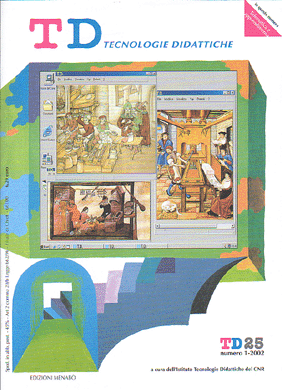La valutazione nella formazione a distanza: un barlume all'orizzonte
Contenuto principale dell'articolo
Abstract
Dettagli dell'articolo
Gli autori che pubblicano su questa rivista accettano le seguenti condizioni:
- Gli autori mantengono i diritti sulla loro opera e cedono alla rivista il diritto di prima pubblicazione dell'opera, contemporaneamente licenziata sotto una Licenza Creative Commons CC BY 4.0 Attribution 4.0 International License.
- Gli autori possono aderire ad altri accordi di licenza non esclusiva per la distribuzione della versione dell'opera pubblicata (es. depositarla in un archivio istituzionale o pubblicarla in una monografia), a patto di indicare che la prima pubblicazione è avvenuta su questa rivista.
- Gli autori possono diffondere la loro opera online (es. in repository istituzionali o nel loro sito web) prima e durante il processo di submission, poiché può portare a scambi produttivi e aumentare le citazioni dell'opera pubblicata (Vedi The effect of Open Access).
Riferimenti bibliografici
Benigno V, Trentin G., (1999), La valutazione nella formazione a distanza, in Trentin G. (a cura di) Telematica e foramzione a distanza . Il caso Polaris, Franco Angeli, Milano, pp. 207-227.
Berelson B. (1952), Content analysis in communication research, Free Press, Illinois.
Bocconi S., Midoro V., Sarti L.. (1999), Valalutazione della qualità nella formazione in rete, TD - Tecnologie Didattiche, n. 16, ed. Menabò, Ortona, pp. 24-40.
Borg W., Gall M. (1989), The methods and tools of observational research, In W. Borg & M. Gall (Eds.) Educational research: An introduction (5th ed.) (pp. 473-530), Longman, London.
Bullen M. (1998), Participation and critical thinking in online university distance education, Journal of Distance Education, vol.13(2), pp.1-32.
Capozzoli M., McSweeney L., Sinha, D. (1999), Beyond kappa: A review of interrater agreement measures. The Canadian Journal of Statistics, vol. 27(1), pp. 3-23.
Garrison D. R. (1991), Critical thinking and adult education: A conceptual model for developing critical thinking in adult learners, International Journal of Lifelong Learners, vol.10(4), pp. 287-303.
Gunawardena C., Lowe C., Anderson T. (1997), Analysis of a global online debate and the evelopment of an interaction analysis model for examining social construction of knowledge in computer conferencing, Journal of Educational Computing Research, vol.17(4), pp. 395-429.
Hara N., Bonk C., Angeli C., (2000), Content analyses of on-line discussion in an applied educational psychology course, Instructional Science, vol. 28(2), pp.115-152.
Henri F. (1992), Computer conferencing and content analysis. In A. Kaye (Ed.) Collaborative learning through computer conferencing: The Najaden papers, (pp. 117-136), Springer-Verlag, London.
Hiltz, S. R. (1990), Evaluating the virtual classroom. In L.M. Harasim (Ed.), Online education: Perspectives on a new environment (pp. 133- 183). Praeger, New York.
Howell-Richardson, C. Mellar, H. (1996), A methodology for the analysis of patterns of participation within computer mediated communication courses, Instructional Science, vol. 24, pp. 47-69.
Kanuka H., Anderson T. (1998), On-line social interchange, discord, and knowledge construction, Journal of Distance Education, vol. 13(1), pp. 57-74.
Levin J. A., Kim H., Riel M. M. (1990), Analyzing Instructional Interactions on Electronic Message Networks. In L. M. Harasim (Ed.). Online education: Perspectives on a new environment, Praeger, New York.
Mason R. D. (1991), Analyzing computer conferencing interactions, Computers in Adult Education and Training, vol. 2(3), pp. 161-173.
Newman G., Johnson C., Webb B. Cochrane C. (1997), Evaluating the quality of learning in computer supported cooperative learning, Journal of the American Society for Information Science, vol. 48(6), pp. 484-495.
Newman G., Webb B., Cochrane C. (1995), A content analysis method to measure critical thinking in face-to-face and computer supported group learning, Interpersonal Computing and Technology, vol. 3(2), 56- 77. In Internet http://www.helsinki.fi/s cience/optek/1995/n2 /newman.txt
Olimpo G., (1999), Qualità, educazione, tecnologia. TD - Tecnologie Didattiche, n. 16, ed. Menabò, Ortona, pp. 4-9.
Riel M., Harasim L. (1994), Research perspectives on network learning. Machine Mediated Learning, vol. 4(2-3), pp. 91-113.
Rourke, L., Anderson, T., Garrison, D. R., & Archer, W. (2001). Methodological issues in the content analysis of computer conference transcripts, International Journal of Artificial Intelligence in Education. In press.
Ruggieri S., Boca S., Ballor F. (2002), Il progetto STRADA: un caso di Formazione a Distanza in ambito universitario, in TD - Tecnologie Didattiche, n. 25, ed. Menabò, Ortona.
Simoff S. (2000), Monitoring and Evaluation in Collaborative Learning Environments. http://kn.cilt.org/ cscl99/A83/.
Thorpe M. (1995), The challenge facing course design, in Lockwood, F. (Ed.), Open and distance learning today, Routledge, New York

